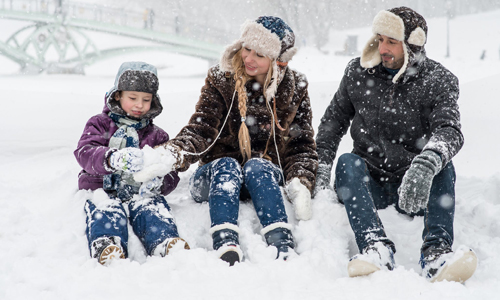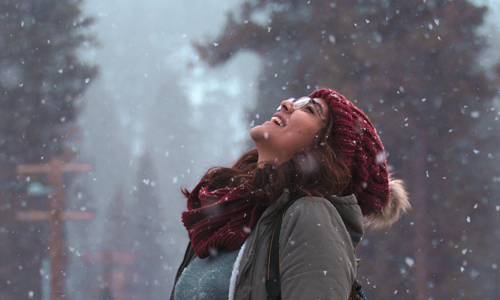A Guide to Dressing up for Freezing Weather
Layering clothes during winter allows you to keep yourself adequately warm according to the changing weather conditions throughout the day. But layering appropriately can be quite tricky. Well, you can’t go wrong if you follow this three-layer principle:
- The Base Layer is worn over the pores and skin. In winter, this deposit often consists of a lengthy underwear.
 The base layers are products of polyester, merino wool, polypropylene, silk or different materials that wick moisture and dry fast. In extra mild weather, this deposit might also consist of a light-weight T-blouse.
The base layers are products of polyester, merino wool, polypropylene, silk or different materials that wick moisture and dry fast. In extra mild weather, this deposit might also consist of a light-weight T-blouse. - The Middle Layer usually includes an extended-sleeved shirt. Button-up shirts are a terrific choice because they're easy to take off and place back on.
- The Third Layer is an insulating layer. In an extremely cold climate, a jacket or a down vest can be used as an insulating layer. The insulating layer will act as your main source of heat. Examples consist of a fleece pullover, wool sweater, and fleece vest.
Now, with the basic knowledge of layering, here are a few simple tips to dress up for the chilling weather appropriately so you can go out in the winters more often.
- When it's really cold, you need to begin with a midweight base layer top and bottoms. They ought to be breathable and moisture-wicking. Merino wool, silk, and polyester base layers are appropriate alternatives.
- Put on your warm socks. Heavyweight and midweight wool-combo socks offer warm temperatures with breathability in cold climate.
- Wear a thick mid-layer, like a pullover or sweater. Polyester fleece and merino wool are also great alternatives.
- Wear your pants over bottoms. Avoid wearing cotton denim and choose water-resistant pants if you are planning on spending considerable time in chilly weather.
- Put on an insulating layer, like an insulated vest or jacket. If you already have an insulated or heavy outer jacket, you may no longer want any further insulating layer.

- Wrap your headscarf around your neck or pull to your neck gaiter.
- Get insulated or coated boots. If there is snow on the floor, make sure the boots are waterproof and feature traction outsoles.
- Put on a pair of insulated mittens or gloves and a warm hat that covers your ears.
- Finally, for your final layer, get yourself a waterproof, insulated jacket or wool pea coat or water-resistant down jacket which can be the best options for cold, snowy conditions.
Follow Outdoor Look
Categories
- Sport (28)
- Product Reviews (3)
- Team Outdoor Look (7)
- Mike Wild (2)
- Mike Payton (2)
- Suse Hammond-Pears (3)
- Snowboarding (12)
- Latest Offers (105)
- Shop Talk (1)
- Competitions (7)
- Walking (413)
- Lifestyle Fashion (8)
- Travel (86)
- Kit Guides (176)
- Workwear Clothing (6)
- Safety Workwear (4)
- Health/Fitness (289)
- Skiing (91)
- Great Outdoors (1316)
- Cycling (92)
Archives
- January 2025
- December 2024
- November 2024
- October 2024
- September 2024
- August 2024
- July 2024
- June 2024
- May 2024
- April 2024
- March 2024
- February 2024
- January 2024
- December 2023
- November 2023
- October 2023
- September 2023
- August 2023
- July 2023
- June 2023
- May 2023
- April 2023
- March 2023
- February 2023
- January 2023
- December 2022
- November 2022
- October 2022
- September 2022
- August 2022
- July 2022
- June 2022
- May 2022
- April 2022
- March 2022
- February 2022
- January 2022
- December 2021
- November 2021
- October 2021
- September 2021
- August 2021
- July 2021
- June 2021
- May 2021
- April 2021
- March 2021
- February 2021
- January 2021
- December 2020
- November 2020
- October 2020
- September 2020
- August 2020
- July 2020
- June 2020
- May 2020
- April 2020
- March 2020
- February 2020
- January 2020
- December 2019
- November 2019
- October 2019
- September 2019
- August 2019
- July 2019
- June 2019
- May 2019
- April 2019
- March 2019
- February 2019
- January 2019
- December 2018
- November 2018
- October 2018
- September 2018
- August 2018
- July 2018
- June 2018
- May 2018
- April 2018
- March 2018
- February 2018
- January 2018
- December 2017
- November 2017
- October 2017
- September 2017
- August 2017
- July 2017
- June 2017
- May 2017
- April 2017
- March 2017
- February 2017
- January 2017
- December 2016
- November 2016
- October 2016
- September 2016
- August 2016
- July 2016
- June 2016
- May 2016
- April 2016
- March 2016
- February 2016
- January 2016
- December 2015
- November 2015
- October 2015
- September 2015
- August 2015
- July 2015
- June 2015
- May 2015
- April 2015
- March 2015
- February 2015
- January 2015
- December 2014
- November 2014
- October 2014
- September 2014
- August 2014
- July 2014
- June 2014
- May 2014
- April 2014
- March 2014
- February 2014
- January 2014
- December 2013
- November 2013
- October 2013
- September 2013
- August 2013
- July 2013
- June 2013
- May 2013
- April 2013
- March 2013
- February 2013
- January 2013
- December 2012
- November 2012
- October 2012
- September 2012
- August 2012
- July 2012
- June 2012
- May 2012
- April 2012
- March 2012
- February 2012
- January 2012
- December 2011
- November 2011
- October 2011
- September 2011
- August 2011
- May 2010
- April 2010
- March 2010
- February 2010
- January 2010
- November 2009
- October 2009
- September 2009
Submit a Comment